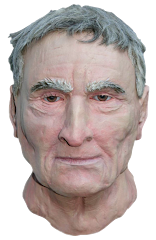 While in Cape Coast we visited the neighbouring fishing town of Elmina. I was very eager to see the famous castle there. My own knowledge had led me to believe that a castle was a building or group of buildings that was the home of the king and his nobles. On entering this castle that perception changed quickly. Eagerness changed to surprise to sadness to anger. I discovered that this castle was used for the slave trade in West Africa.
While in Cape Coast we visited the neighbouring fishing town of Elmina. I was very eager to see the famous castle there. My own knowledge had led me to believe that a castle was a building or group of buildings that was the home of the king and his nobles. On entering this castle that perception changed quickly. Eagerness changed to surprise to sadness to anger. I discovered that this castle was used for the slave trade in West Africa.Built in 1482 by Portuguese traders, Elmina Castle was the first European slave-trading post in all of sub-Saharan Africa. It was originally built to protect the gold trade but following its capture by the Dutch in 1637, it came to serve the Dutch slave trade.
 Elmina housed luxury suites for the European masters on the upper levels. The male and female slave dungeons below were cramped and filthy, each cell often housing as many as 200 people at a time, without proper ventilation or light, without toilet facilities or even enough space to lie down. The floor of the dungeon, as result of centuries of impacted filth and human excrement, is now, we are told, several inches higher than it was when it was built. Outbreaks of malaria and yellow fever were common. Staircases led directly from the governor's chambers to the women's dungeons below, making it easy for him to select personal concubines from amongst the women. It was not uncommon for the slave masters to rape women.
Elmina housed luxury suites for the European masters on the upper levels. The male and female slave dungeons below were cramped and filthy, each cell often housing as many as 200 people at a time, without proper ventilation or light, without toilet facilities or even enough space to lie down. The floor of the dungeon, as result of centuries of impacted filth and human excrement, is now, we are told, several inches higher than it was when it was built. Outbreaks of malaria and yellow fever were common. Staircases led directly from the governor's chambers to the women's dungeons below, making it easy for him to select personal concubines from amongst the women. It was not uncommon for the slave masters to rape women. One of the saddest moments for me was entering the church on the second floor of the castle. Under the church was the dark room with The Door of No Return, the infamous portal through which slaves boarded the ships that would take them on the treacherous journey across the Atlantic known as the Middle Passage. By the 18th century, 30,000 slaves on their way to North and South America passed through Elmina's Door of No Return each year.
One of the saddest moments for me was entering the church on the second floor of the castle. Under the church was the dark room with The Door of No Return, the infamous portal through which slaves boarded the ships that would take them on the treacherous journey across the Atlantic known as the Middle Passage. By the 18th century, 30,000 slaves on their way to North and South America passed through Elmina's Door of No Return each year.On the wall of the Church are the words from Psalm 132 … “Here shall I rest for evermore, here shall I make my home as I have wished.”
I asked myself ‘where did God rest for evermore, where did he make his home, was it in the well lit and well ventilated church on the second floor of the castle or was it in the dark dingy room of no return?’ With strong conviction, I could sense god’s presence in the room of no return.
 As I left the castle I prayed for all the Africans who died in the castle that god may give them eternal rest. I prayed for all the Europeans who perpetrated this horrible atrocity on our grandmothers and grandfathers. Even as prayed I was reminded that slavery exists even today albeit in very many different forms. And so I prayed for all of us living today in the words of Nelson Mandela, “Never, never and never again shall it be that this beautiful land will again experience the oppression of one by another.”
As I left the castle I prayed for all the Africans who died in the castle that god may give them eternal rest. I prayed for all the Europeans who perpetrated this horrible atrocity on our grandmothers and grandfathers. Even as prayed I was reminded that slavery exists even today albeit in very many different forms. And so I prayed for all of us living today in the words of Nelson Mandela, “Never, never and never again shall it be that this beautiful land will again experience the oppression of one by another.”Paul S Yallah and Samuel M Ngumi











No comments:
Post a Comment